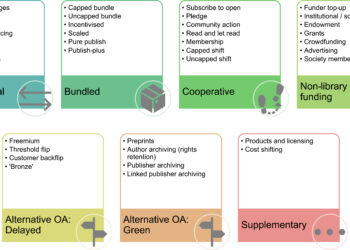
Yesterday, in the first part of this three-part series, I outlined the risks we’re courting by allowing governments, with all the political and bureaucratic propensities therein, to exert explicit influence over scientific publication, editors, and authors, a trend introduced and enabled by open access (OA) publishing and manifest in mandates and threats to funding and grants. Governmental priorities have the potential to influence scientific publishing by stifling new avenues of research, robbing from research funds to pay publication charges, and moving scientific publishing into a captive service industry. Government involvement courts both the predictable aspects of government bureaucracies and the unpredictable nature of political involvement.
Today, the changing role of funders — governmental, corporate, and philanthropic — is the focus.
The Problematic Role of Funders
Funders are the gamblers in science. They place bets on research teams, hypotheses, and protocols, and hope that their gambles result in scientific advances. The fact that they place a bet doesn’t mean that the bet will pay off — patient enrollment can be a problem; materials may not interact as anticipated; the hypothesis could be wrong. There are many ways for scientific gambles to crap out. It’s important for the results of their bets to be judged as objectively as possible, to see what was gained. So when funders start running a casino of their own because they begin to believe that appearing to win is a goal, it becomes difficult to know if the dice are loaded or the cards stacked. And when they begin to throw their weight around to influence their neighborhood so that everyone who agrees with them starts to get payouts, it starts to feel more like something out of GoodFellas.
As the past decade has unfolded, some large funders — Wellcome, the US National Institutes of Health (NIH), the Research Councils UK (RCUK), the Howard Hughes Medical Institute (HHMI), and Max Planck, to name a few — have aligned with OA activists. OA shares some key priorities with funders — barrier-free dissemination and a higher probability of publication. Funders have also been using author mandates to ensure that papers emanating from their funding are made available following rules they impose on authors and, through them, publishers. Wellcome Trust has been one of the more active in this regard, with the Howard Hughes Medical Institute, the NIH, and others following suit. Funder mandates are meant to influence the business of publishing, which impacts many aspects of journals, including how titles are launched, authors funded, and editors paid.
However, philanthropic and government funders aren’t the only funders in the game — corporate funders also play, and they stand to benefit a great deal from emerging trends in OA publishing. The push to accept more papers on the premise that this creates “openness” means that corporate funders can begin their publication plans by seeding papers in OA journals. Using these as a reference basis for subsequent papers, pharmaceutical and other corporate interests can ladder up the literature, ultimately appearing more legitimate and legitimized than they should. Is this going on? One study found that industry authors were more than twice as likely to pay OA fees, a clear sign that corporations are finding a benefit in these high-acceptance venues.
Pay-to-play publishing favors those who can pay, but also distorts how publications evolve and definitely changes how publications launch. Today, it’s not uncommon for publishers to see who is funding research in an area and how they pay OA charges before launching a title. A PLoS representative recently described how they are working to demonstrate the value of their publications to funders. Such obeisance to funders is a new phenomenon, and not a healthy one.
One OA publisher has gone so far as to allow funders to have insights into their editorial tracking, ostensibly in order to track payment status, but the access clearly has other potential uses, which are rationalized away. In addition, despite article processing charges (APCs) coming from corporate funders, this publisher does not disclose the sponsorship on the actual papers or make editors aware of potential corporate funding, leaving editors unable to evaluate and readers unaware of a new conflict of interest. This speaks to the priorities created by funder-paid publication and the power of funders in the OA world — actions or inactions are rationalized to ensure funders are comfortable with their new paths into the publications process.
Recently, a set of funders went beyond indirect influence to direct participation — funders became publishers. This is a truly troubling situation for scientific publishing — fundamental conflicts of interest make funder-publishers untenable. In addition, these funders collaborated with government funders to use taxpayer funds to accelerate the new journal’s launch and indexing, further illustrating how power corrupts when unchecked. This willingness to exercise insider power without shame or apparent risk of embarrassment should give us pause, especially as the three senior editors of this new journal are each individually funded by one of the three funders of the journal. As Dan Fields wrote in a recent piece in the Huffington Post:
Do we want a . . . system in which the money for research is supplied by the same body that validates and publishes it?
Journal editors and reviewers are supposed to provide unbiased review and publication of scientific research results, creating an objective layer of quality and relevance placement. I don’t think lay society, if the basics of funder-publishers were explained in plain language, would accept that we’re sitting idly by while funders launch journals — whether these funders are commercial entities or not-for-profit philanthropies. Editors are supposed to be independent, as are journals. This is the basis of our social contract.
Even if funders weren’t going as far as launching journals, there are aspects of a funder-pays world we have yet to fully understand or grapple with.
- How will the money be distributed?
- How sensitive will funding be to economic realities (i.e., will funding be reliable?)?
- How will the “have nots” compete with the “haves”?
Authors only provide 1% of the interactions with journals that readers do, and there is a robust and diversified economy around subscription journals, which makes them more affordable for more people and less susceptible to influence. How will concentrated payments from fewer sources skew publishing policies and practices? Certain scenarios could dramatically undermine or limit scientific publishing for decades, yet it is nearly impossible to have critical discussions about these possibilities without the threat of further funder activism as a backlash, an almost obstinate response of force to reason.
Funders and OA advocates align in their belief that nothing can go wrong with OA. For funders, there is little downside in the short-term, and their reputations are sheltered by journal brands, who take the brunt if a published study is found lacking. For philanthropic funders, OA is a route to further demonstrating their value and attracting more funding themselves. For corporate funders, OA provides not only a nice path for publication planning, but also free papers for their scientists, saving these big corporations significant sums in licensing fees. But there is also an amount of magical thinking at work. As Joe Esposito wrote in a prescient 2004 essay:
[To its advocates, OA] has been granted a unique dispensation from the Law of Unintended Consequences. . . . Many of the proponents of OA seem to believe that the imminent OA regime will look very much like the current proprietary paradigm. . . . Unfortunately, many OA advocates have as limited an understanding of the systemic dimension of information creation and delivery as Shylock pretended to have of biology: take one pound of flesh, please, but not one drop of blood.
Clearly, unintended consequences are all around us already — new conflicts of interest, funders becoming publishers, corporations exploiting OA inputs and outputs, and governments dictating terms for the publishing industry.
It’s worth reminding ourselves of three factors that make funders so powerful, and potentially so difficult to resist, in scientific publishing — their relative size, their ability to coordinate large and long-term funding strategies, and their inherent alignment. Allowing them into the henhouse, even if they seem benign initially, changes things. And they want things to change — whether corporate or philanthropic, more publications are clearly their priority, and they are willing to pay and leverage their grantees to achieve this.
The notion that “more is better” aligns OA publishers and funders — each wants more papers published, both philosophically and for commercial reasons. Their interests tilt toward quantity — for funders, more publications justify their spending and helps to attract more funding or corporate support; for OA publishers, more papers improve their bottom lines and increase their online traffic. However, there are two problems — first, the funding approaches behind OA are susceptible to caps and cuts; second, there isn’t a commensurate set of incentives for quality.
Judging from their public statements, the bureaucracies within funding bodies do not understand or respect how scientific publishing works or appreciate the value of a disinterested system of experts validating research reports — if they did, they would not fund their own journals. They also do not, and perhaps cannot, respect the social contract scientific publishing has cast for itself — for independence, disinterested review and validation, and quality. Their publication priorities emanate from their desire to demonstrate their efficient use of funds. They are now in a position to not only dictate prices, terms, and other aspects of authors’ and editors’ lives, but are paying editors of their own. The blind belief that OA can do no wrong has put a hole in the wall between funders and publishers,. Worse, vigorous debate is no longer allowed, and the course seems set. Money talks.
Governments and funders as sources of money in scientific and scholarly publishing — where it might come from, the economic and social prices it might impose, and the way it is being wielded — will be the subject of tomorrow’s post.
Discussion
3 Thoughts on "New Players, New Priorities — Part 2: The Problematic Role of Funders"
Nobody loves Robert Maxwell but one good thing he did was to take payment out of publishing, simply by starting loads of journals with no author charges. The market was forced to follow his lead. Now author charges are on their way back, as part of OA. How is this a good thing? As well as the subtle corruptions the article alludes to, author charges are already calling into existence predatory publishers; how far up the chain of respectability will the tendency to publish a marginal paper which has fees attached, rather than reject it, go? To what extent will researchers, who formerly could publish wherever they liked or wherever they were able to get published, find themselves directed to ‘approved’ publications which might not be their first choice, or which might not be keen to publish their work? ‘Approved’ by whom, and on what basis? That OA is one answer (but by no means the only one) to the scholarly communications crisis is an argument that has some merit; that APCs are the mechanism which will make OA work is possible, but likely to call into existence a different crisis at some point: scholarly communication will have become affordable but irredemiably corrupted.
Some of those who advocate OA also call for a different kind of peer-review system, emphasizing post-publication peer review more than pre-publication. But one wonders how susceptible that kind of system might be to corrupt practices also. Just think of how reviews on Amazon are now written frequently by friends of the author. One can imagine that funders might pay or otherwise coax “experts” to write positive reviews of published articles in similar fashion.



